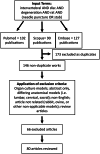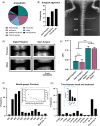Rat tail models for the assessment of injectable nucleus pulposus regeneration strategies
- PMID: 36203865
- PMCID: PMC9520766
- DOI: 10.1002/jsp2.1216
Rat tail models for the assessment of injectable nucleus pulposus regeneration strategies
Abstract
Back pain is a global epidemiological and socioeconomic problem often associated with intervertebral disc degeneration; a condition believed to initiate in the nucleus pulposus (NP). There is considerable interest in developing early therapeutic interventions to target the NP and halt degeneration. Rat caudal models of disc degeneration have demonstrated significant utility in the study of disease progression and its impact on tissue structure, composition, and mechanical performance. One significant advantage of the caudal model is the ease of access and high throughput nature. However, considerable variability exists across the literature in terms of experimental setup and parameters. The objective of this article is to aid researchers in the design and development of caudal puncture models by providing details and insight into the most reported experimental parameters. Preferred Reporting Items for Systematic Reviews and Meta-Analyses (PRISMA) guidelines were employed to screen the existing literature and 80 manuscripts met the inclusion criteria. Disc geometry, surgical approaches, effect of needle gauge size to induce degeneration, therapeutic volume, outcome measures, and associated limitations are considered and discussed, and a range of recommendations based on different research questions are presented.
Keywords: degeneration; intervertebral disc; nucleus pulposus; puncture; rat tail model; spine.
© 2022 The Authors. JOR Spine published by Wiley Periodicals LLC on behalf of Orthopaedic Research Society.
Conflict of interest statement
The authors declare no conflicts of interest.
Figures






References
-
- Setton LA, Chen J. Mechanobiology of the intervertebral disc and relevance to disc degeneration. J Bone Joint Surg Am. 2006;88(2):52‐57. - PubMed
-
- Trout JJ, Buckwalter JA, Moore KC, Landas SK. Ultrastructure of the human intervertebral disc. I. Changes in notochordal cells with age. Tissue Cell. 1982;14(2):359‐369. - PubMed
-
- Shankar H, Scarlett JA, Abram SE. Anatomy and pathophysiology of intervertebral disc disease. Tech Reg Anesth Pain Manag. 2009;13(2):67‐75. doi:10.1053/J.TRAP.2009.05.001 - DOI
-
- Adams P, Eyre DR, Muir H. Biochemical aspects of development and ageing of human lumbar intervertebral discs. Rheumatology. 1977;16(1):22‐29. - PubMed
-
- Roberts S, Menage J, Urban JPG. Biochemical and structural properties of the cartilage end‐plate and its relation to the intervertebral disc. Spine (Phila pa 1976). 1989;14(2):166‐174. - PubMed
Publication types
LinkOut - more resources
Full Text Sources
Miscellaneous

